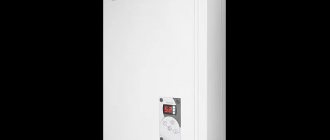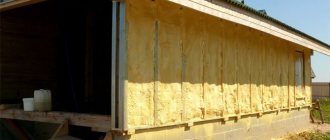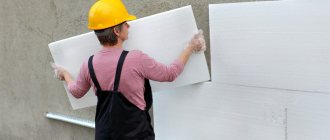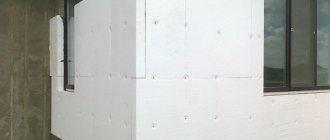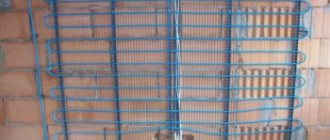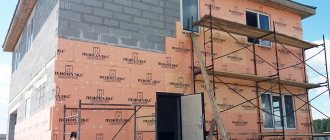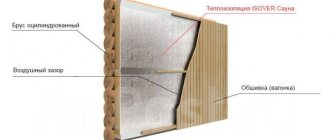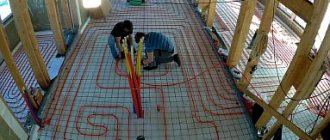Hello dear readers. If you came to visit us again, you are either simply bored, or, most likely, you are looking for sensible advice. No wonder. It’s no longer May outside the window and I would like to save at least a little on heating.
You have probably already encountered the unpleasant fact that 90% of topics on the Internet that relate to popular materials are either paid for by manufacturers or do not contain at least some sensible information. But we know how to insulate a house inside correctly and without PR. And today we decided to share our experience with you. Read on.
I decided that I would not tell how I insulated my house or how I helped my friends or neighbors do it. Each of them has their own project. And those tips that helped some people back then may turn out to be absolutely useless for you.
At the request of workers, in this review we will consider only those sets of measures that can be carried out inside the house, leaving facade insulation for a separate article.
Material selection
There are a number of requirements for thermal insulation materials.
The insulation must have low thermal conductivity, good hygroscopicity, fire safety and environmental friendliness.
It is necessary that the material reliably prevents heat exchange between the external and internal parts of the walls and protects the structure well from the inside.
Today, mineral wool based on basalt or fiberglass is widely used as insulation. If the ventilation of the house is properly equipped, moisture will not be a problem for this material.
New products for high-quality do-it-yourself insulation of a dacha are constantly appearing on the construction goods market. For example:
- insulation made of flax fiber - the material is produced in slabs, is easy to cut, does not change shape, is environmentally friendly, has good antiseptic properties;
- ecowool is a sprayed loose heat insulator consisting of recycled cellulose with the addition of antiseptics and fire retardants;
- soft fiberboard (fiberboard) is an environmentally friendly material that can be used to immediately strengthen walls.
How and with what to insulate is a matter of taste and good choice. The main thing is that the country house is reliably protected from the winter cold.
Technology and stages of external insulation of a country house
Technological features of external thermal insulation in the form of a ventilated facade include the following stages.
Preparatory work
The facade walls are treated with antiseptics in two layers to eliminate the risk of rotting. The product is applied especially carefully, including on corner surfaces and the crown. The treatment is carried out in dry weather and left to dry for 24-36 hours.
Arrangement of metal or wood sheathing
An insulating film with a vapor-permeable coating is attached to the wall, with the porous side facing the wall and the glossy side facing the street. Next, a vertical wooden sheathing is constructed. To ensure a tight fit of the mineral wool mats, the interval between the beams is maintained 4-5 cm less than the width of the insulation.
Laying thermal insulation material
Lay insulator slabs between the sheathing bars and, if necessary, temporarily attach them with slats. The final fixation of mineral wool is carried out using anchor nails. When installing mats in two layers, a technique with offset seams is used, that is, the elements of the second layer cover the tile joints of the first.
Next, a layer of wind and waterproof membrane is performed with the material overlapped using a stapler. Mounting tape is used to seal joints. The next step is to install the ventilated frame:
- the structure is constructed from the same bars that were used for lathing under the mineral wool mats;
- The ventilation frame bars are installed to the previous sheathing using self-tapping screws.
In this case, a technical gap is left between the insulation and the frame for ventilation.
Finishing activities
The following materials are recommended for cladding a country house:
- imitation timber;
- lining;
- block house;
- wood-look vinyl siding and other solutions.
Blockhouse - material for cladding a country house.
The cladding material is attached according to the manufacturer's instructions. It is important to eliminate any gaps to prevent the risk of moisture seeping into the insulation system.
Roof
If installed incorrectly, a roof can “steal” more than 10% of the heat spent on heating the house.
When choosing thermal insulation for a roof, pay attention to its service life, which depends on many external factors: temperature fluctuations, amount of precipitation (especially snow), wind strength and direction. Pay special attention to the water resistance of the material. Isolation must also be safe for health. The first sign of safe insulation is the absence of a sharp, pungent odor.
Insulating the roof with polymer materials is not the best solution. They ignite very easily and quickly, so increased fire safety measures will have to be taken.
The best insulation for roofing can be considered stone wool, which is intended for thermal protection of structures that do not bear heavy loads.
Audit
So, where should an owner begin who has undertaken to turn his home into a frost-proof fortress? Of course, from the audit! To plan your future actions, you need to understand how things are at the moment.
We will move from bottom to top.
First, let's check what gender we have. If it is just a poured concrete screed or plank flooring, it cannot be warm a priori, which means it needs to be insulated.
Then look at the carpentry - these door and window openings very often serve as the main factors of heat loss, which means they can easily ruin you.
Next are the walls. If you have an ordinary brick house, then in order to satisfy SNiP requirements, the width of your wall without insulation should be around two meters. Is it really less ☺? Then the walls need to be improved.
Now we have to check the attic floor and, of course, the roof. I can tell you from experience, since you are reading this article, the attic and roof were definitely left without proper attention - if not, sorry, I could have made a mistake ☺.
Walls
Insulation of walls is the main stage of work, since they occupy the main area of any building and have the highest heat transfer.
Surface preparation
Before insulating wooden walls, be sure to clean the entire surface of dirt. Carefully treat the inside of the walls with special solutions and aerosols that will protect the wood from insects. Then caulk all the gaps using dry tow and a thin chisel.
Insulation
Jute fabric is very suitable as a heat insulator for walls. It is quickly and easily laid with a construction stapler, does not rot, is not blown away by the wind and is not of interest to moths. Tow and jute fiber have low thermal conductivity due to their capillary structure and easily release moisture. In addition, as bactericidal materials, they successfully resist the spread of fungus.
It is not recommended to use improvised materials to insulate the walls of a country house: felt, batting, wool. They accumulate moisture abundantly. As a result, the process of rotting quickly begins, and moths are sure to appear in the wool.
Preferred insulation materials for house cladding
Each material has pros and cons. Based on the information presented above, you can make a symbolic rating of the highest quality materials for the walls of a house (the first is the most preferable, etc.). It is also worth considering the type of facade design.
For ventilated systems, wool - mineral, cellulose - is better suited. When laying wells, preference should be given to materials that do not allow moisture to pass through. This is extruded polystyrene foam. Plaster finishing of walls goes well with insulation, whose density is more than 30 kg/m3. For example, with mineral wool, polystyrene foam, polystyrene foam, and any organic material.
A country house must be high-quality sheathed with reliable material. The consumer can choose any of those discussed earlier, guided by his wishes or financial capabilities. A competent approach to purchasing insulation is the key to the long service life of a cozy home.
Window
After insulating the walls, we move on to the windows. They also lead to significant heat loss, so close attention should be paid to windows, especially if the design is outdated.
Cleaning and waterproofing
The frames of the house should be thoroughly cleaned of dust, cracked glass should be replaced, and the gaps between the walls and frames should be sealed.
For high-quality insulation you will need silicone sealant in a special gun. It reliably protects joints from the inside from fungi and mold.
Polyurethane foam will also work. However, it quickly deteriorates from the sun and is not entirely aesthetically pleasing. If you choose foam, you will have to take measures to protect it from ultraviolet rays.
D-profile tape
Then you need to glue the sealing tape. D-profile tape is best suited. It effectively closes gaps up to 7 mm. For a more secure fixation, you can secure the tape with nails or staples.
Film on glass and insulation of slopes
To maximize the insulation of windows, cover them with heat-saving film. This material is applied directly to the glass. When laying the film there should be no folds, swelling or bubbles. Carefully done work will help save more than 30% of heat.
Don't forget about insulating the slopes. For this, you can use various materials, for example, polyethylene foam or mineral wool. The insulation is fixed to the slopes using glue.
Carpentry
And it’s a no-brainer that if you still have old Soviet windows in your house, then you heat not only the room, but also your yard. The thermal conductivity of glass is 0.81 W/ (m*K), exactly the same as that of brickwork, although the thickness is only 3-4 mm.
The glass unit is another matter. Properly manufactured, it significantly increases the heat transfer resistance of a window unit, and therefore people, without hesitation, take two, three, and if they sell even five chamber glass products.
The trap is that the optimal chamber width is 16 mm, and the width of the produced window profile is 32 mm.
It would seem that a two-chamber product can still be “fitted” tightly, but let’s add the thickness of the glass, and there will be as many as 3 of them and we’ll get an extra 1.2 cm.
It is important not to chase the chambers, but to understand that it is not the glass that retains heat, but the air sandwiched between them, and if the amount of this air is reduced by the same volume, heat loss will only increase.
Conclusion: not everything is good because it’s expensive!
Floor
There are many modern materials for floor insulation. The main thing is that the inside of the country house is as dry as possible.
Styrofoam
Expanded polystyrene does not absorb moisture, is durable, strong, and a good antiseptic. It is convenient to work with such material because it does not change the original volume.
Minvata
Mineral wool is sold in various versions: rolls, slabs, mats. Low density, environmental friendliness, wear resistance, relatively low price are its main advantages.
Penofol
The new material penofol has already shown its best side and has gained popularity. It is sold in rolls consisting of a layer of foil and insulation. Most often, the base is foamed polyethylene.
Requirements for insulation
When choosing a material for insulating a dacha floor with your own hands, do not look for the cheapest options and be sure to remember that the insulation must be:
- environmentally friendly, safe for health;
- excellent heat insulator;
- durable.
Spraying polystyrene foam
In addition to the insulation method described above, you can also insulate the building by spraying polystyrene foam. A special composition is sprayed onto the surface of the wall - after drying, it creates a continuous insulating coating. The main advantage of this method is the ease of application to textured surfaces - this is especially true if country houses made from block containers are to be insulated.
The disadvantages include the complexity of the work - it requires specific skills and increased personal protective equipment. It is also mandatory to purchase or rent specialized equipment. This method is not very suitable for manual application, however, the ability to create a seamless coating in hard-to-reach places is worth resorting to the services of specialists.
Insulating your dacha from the outside will help you significantly reduce the cost of heating the building. You can get more detailed information by watching the video in this article.
Related article: How to make a relief design on a wall
Floor insulation methods
There are several ways to insulate the floor of a country house.
Double floor
The bottom layer of rough boards is carefully attached directly to the beams. A “finish” coating is laid on the “rough” structure.
Floor insulation using joists
Wooden logs are installed on the foundation in increments of 0.5–1 m or cut into the frame. Next, the “rough” floor is laid. The free space is filled with thermal insulation. Quite a simple and effective way. You can insulate the floor using joists installed on brick columns. Any insulation: mineral wool, fiberglass, polystyrene foam or other suitable material. The distance between the finished floor and the ground increases. The work does not require builder experience and can be easily done with your own hands. With this option, the insulating material does not experience stress, which makes the method of insulating a wooden floor along joists ideal.
Insulation of a garden house for living in winter
Floor insulation
First, you should insulate the base with polystyrene foam and the floor on the first floor.
Most often, in dachas, the floor is made of wood, so we will consider this particular design. If you want to save money, you can use traditional materials - sawdust or expanded clay. If you take your work more seriously, then you can insulate the floor using mineral wool over wooden joists.
Thermal insulation of walls
If the house in the garden is built of sand-lime brick or timber, then insulation must be done from the outside.
In this case, you will save space in your living space and protect the walls of the building from freezing and the possible appearance of mold. It is best to insulate the facade with mineral wool followed by finishing with vinyl siding. Read how to choose the right mineral wool on our website here.
Insulation of the facade of a house without cold bridges
Attic insulation
A private house loses the most heat through the ceiling, since warm air always rises.
It is better to do insulation from the side of the cold attic. On horizontal surfaces, you can use traditional and inexpensive bulk materials - sawdust mixed with soil or expanded clay. If mineral wool is used, then a roll vapor barrier is first laid on the surface.
Tips for installing a heat insulator
Let's look at three tips:
- When insulating the walls of a country house from the inside, you need to know that the inner layer of heat insulation will take up useful space. Therefore, it is best to insulate small country houses from the outside.
- During installation, it is also necessary to take care of creating a ventilation gap, which should be located between the heat insulator and the decorative finish. What is the purpose of the ventilation gap? It is necessary so that the thermal insulation cake of the walls can be ventilated and the condensation can evaporate better.
- When carrying out a vapor barrier, be sure to use a specially designed film, which will protect the heat insulator from getting wet and freezing. It will protect the heat insulator from losing its original technical characteristics.
This anti-condensation film can be used for vapor barrier and waterproofing not only walls, but roofs.
Correct work with insulation
Depending on the type of building and its features, it is determined what work needs to be done to make the building suitable for living in in winter. However, the main types of work are reduced to several stages.
First of all, the floors. The cheapest option here would be expanded clay or wood sawdust, if the former does not allow the use of the nature of the building. The best option in this case would be mineral wool; it will be more effective, but will be much more expensive. Most often, the insulation is either laid among the joists or laid under the screed. The attic is insulated in exactly the same way.
The most difficult stage is working with windows and doors. They are the source of large amounts of heat loss. The most important thing here is to make sure that they fit tightly to the house, and also remove all possible cracks. It is best to install professional windows, which will also protect from external noise, and the quality of insulation will be much higher.
However, it is best to immediately think about the future, and if the budget allows, build right away so as not to remodel the house again later. The insulation incorporated into the primary structure of the house is much more effective, and in addition, it does not require any redevelopment, and the financial costs are actually much lower.
